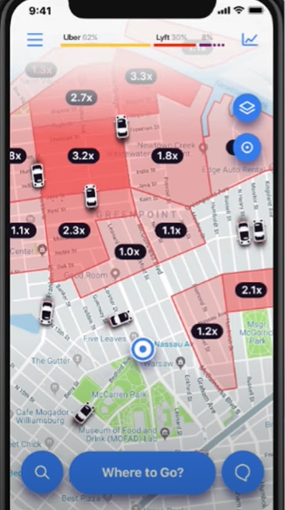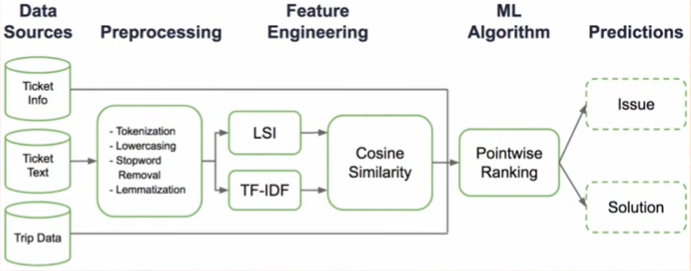Hello Techies!! Hope You all are Safe and doing Amazing, As I promised in my previous Article about case studies of Big-AI Giants. if you haven't read that article please read that article here.
This Is the very first Case study article and I choose Uber cuz, It's Known to be an AI-first Company. AI-first Company means it uses AI in all aspects of decision-making. hence, I'll discuss How uber becomes an AI-First Company, and how it ceaselessly scales up and maintains customer services. How did this Ride-Hailing Giant Make It To The Top??. all about uber products and how uber is applying machine learning to their business units. along with that how they used machine learning for huge Data-driven decisions from delivering your order🍟🍔 on time to dropping you in-office before scolding😶.
Before diving directly into the topic, let’s first know about Uber MNC.
In the 21st century, every tick-tock of the clock counts and in such a scenario even the idea of waiting in queues for buses or autos does not seem good. Garrett Camp, Oscar Salazar & Travis Kalanick founders of uber came up with an idea in 2009 to make every tick-tock count and enhance the traveling experience. Over the years it has gained popularity and revenue up to $5.78 billion as of 2021 and has become the one-stop riding solution for many people. Uber has a huge base of over 93 million monthly active users, as of 2022. Subsidiaries of uber are Uber Eats, Jump, Otto, Postmates, Careem, Cornershop Inc., and More…
Uber is the most popular in the world and among common people for Food and travel. so let’s understand how UberEats and UberCabs work and efficiently use our data for machine learning and decision-making to scale up the business.
Uber & Uber Eats:

The major machine learning workflow at uber is managed by uber’s machine learning as a service software i.e. Michelangelo. it was created as a solution to the problem of expansion of the company into various countries, It became difficult to manage the data. It was basically developed by uber’s data science team to scale up the data collected from various countries. we can say it’s an ML cloud of uber i.e. all data under the same shell.
Michelangelo enables internal teams to seamlessly build, deploy, and operate machine learning solutions at Uber’s scale. It is designed to cover the end-to-end ML workflow: manage data, train, evaluate, and deploy models, make predictions, and monitor predictions. The system also supports traditional ML models, time series forecasting, and deep learning.
Currently, the 3 types of models we can create under Michelangelo are Machine learning, deep learning, and NLP.
The features of Uber where extensive machine learning/Deep Learning is used are:
- ETA(Estimated time of arrival): on the Uber app when we book a cab, with the help of GPS we can track its path as well. but have you ever imagined the cabs exactly reaching the destination as per the Estimated time on the app😮. it exactly estimates, how much time is required to reach the destination, On how much time our order will reach our door. how?? how??.
Traditionally, as we know routing algorithms are used to calculate ETA i.e. from the source various paths to reach the destination are counted or Graph is created->then weights are assigned to each counted path-> and then by using the shortest path algorithm ETA is calculated. but this method doesn’t care about real-life scenarios like weather, rain, road construction, accident, traffic congestion, etc. Hence to solve these uber used ML over the traditional method.
From the historical data and real-life data, they created a GradientBoosting model to increase the accuracy of prediction. furthermore, as data increased they switch to XgBoost and it became the most powerful algorithm in ML. But to handle the TB of data further they switch to Deep Learning and created the DeepETA model(its transformer-based Encoder-decoder architecture with self-attention). its created & deployed using Michelangelo.
2. Ensure the Demand-supply gap: After solving the problem of time, another problem that arise was that if more customers available in a particular area then that much cabs should be available at that moment of time in that particular area as well. but sometimes, we faced no cabs available in this area issue. hence to solve this uber make use of Machine learning.
but, How it uses ML?? actually, uber work on this problem in 2 stages discussed further.
Prediction of the demand 🛒: As per the historical data, model tries to predict how much cabs will be required or how many riders can book a cab in a particular area at a particular time. so, 2019 onwards Uber started using a deep learning architecture “Gini” that based on past data using time-series forecasting predicts riders in a area.
Surge Pricing: after knowing the demand, how to ensure the supply?? that much supply/cabs should go in that area. but someone why travel miles for less money. so, that’s why for such area uber increases the fair of cabs indirectly gives greed to drivers😙. that’s how sometimes fair increases for same travelling. Form the below heatmap you can see driver get this map and as per the high demand(red hexagon) and price, they switch to high demand location.

but, How does uber calculate the fare of a cab??
$$\displaylines{ Fair = (base fair + (\frac{cost}{min} \times time) + (\frac{cost}{km} \times time)) \times surgemultiplier. }$$
Now it’s the Time Of NLP in Uber,
one-click chat 👆: Uber’s chat feature is the best NLP application in which we can chat with the driver to know its location or any other kind of issue. but have you imagined how the driver can type an on-demand message to a rider during cab riding or in traffic??. hence to give ceaseless service to customers they used NLP instead of manual work by the driver. that NLP work in 2 stages, first is intent detection from the message i.e. from the message that the rider type the NLP model deployed on the server detect the intent of the message and based on that, whatever replies are already there in the system, it compares intent with those replies and generates confidence score with each one. lastly, the 4 higher confidence scores are displayed on the driver’s screen, and hence appropriate reply with just “one-click” is given by the driver.
Customer Support 🤝: As the no. of customers increases, their issues are also raised to that extent. instead of resolving those issues manually by a team, Uber used NLP to create an Application named COTA(Customer obsession ticket Assistant): it's an NLP +ML-based system that actually does 2 tasks as follows:
2.1 classifies the ticket/issue: when we raised an issue it generates cross-questions to collect the data from the rider/user. it generally works on trip details, rider-driver details, or fair related data and it particularly gives more attention to issue data. it processes that data at word level & generate topics for the issue by using topic modeling. extracted features then fed to cosine-similarity based pointwise algorithm made by Random forest. you can see the workflow of COTA below.

2.2 generates the solution*: after the above process generated topics are then compared with historical topics in the system and with that generates the possible solutions. so, the rider can resolve the issue on its own.*
COTA worked efficiently and 10* reduces customer support time. it was built and deployed over Michelangelo.
Another area Not out of sight of Uber was Fraud Detection. let’s see how it works??
3. Fraud Detection: ceaseless service and customer experience are on one side and transaction of the fair is another part. Uber supports multiple payment methods and it has expanded to over 80 countries. so, there is more likelihood of fraud occurrence in transactions, instead of detecting them manually by a team, they proposed a machine learning system called RADAR(Real-time anomaly Recovery). below dig. shows the RADAR workflow.

RADAR is an AI fraud detection and mitigation system with humans in the loop. RADAR keeps track of the transaction, if any payment fails or stucks in between then a spike in the transaction process occurs. so, RADAR detects that applies an anomaly detection algorithm, which analyses the issue and passes it on to a risk analyst to finalize and resolve the fraud.
This is How Uber uses AI and becomes an AI-First company. but this is not the End recently, Uber is working on an open-ended technology-based algorithm called POET(Paired open-ended Trailblazer), which on its own creates problems and solves them as well.
Another area where Uber is still researching is Self- Driving Cabs.
🎉Hence that’s the Final End 🎉
If you like this article or if you’ve any suggestions then do comment 👇. and follow us for more such AI-related Content and subscribe to our newsletter to make your learning seamless. connect with me on Linkedin, github.
Thank you, Stay tuned for the next AI-giant case study!!. till then explore and show your love💜 towards my articles;)
Happy Learning!!🥳

